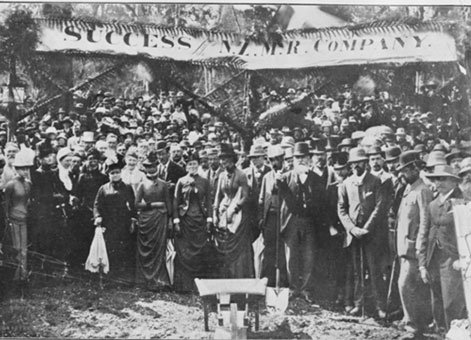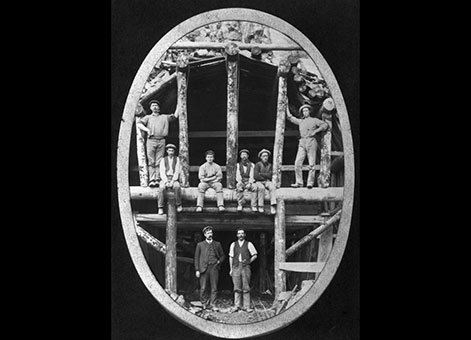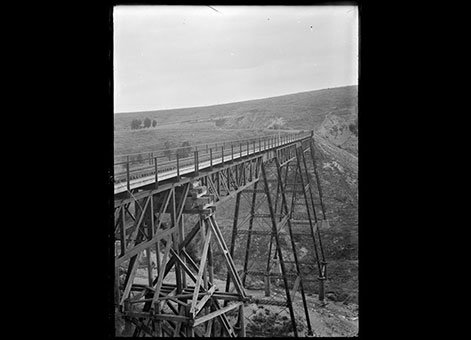The South Island’s east to west coast railway opened in 1923 after 36 years of challenging construction, which included five major bridges, five viaducts and 17 tunnels.
Railway development in the South Island in the 1870s was concentrated on a main line linking the established east coast centres of Christchurch, Timaru, Dunedin and Invercargill. From this, light and easily constructed branch lines served the arable plains. These later included a branch to Springfield, which was reached by January 1880.
In 1882 the East and West Coast Railway League formed. By 1884 two routes had been scoped for a Royal Commission to choose from: the more direct, but technically difficult, Waimakariri Valley-Arthurs Pass route, or the somewhat easier Hurunui Valley-Harpers Pass route, which was longer. The Commission decided on the Waimakariri Valley-Arthurs Pass route.

Midland Railway Company ceremony, 1887. Heinz, William Frederick, 1900?-1976: Photographs and negatives of gold mining and other facets of West Coast life. Ref: 1/2-044392-F. Alexander Turnbull Library, Wellington, New Zealand.
However, the economic depression at this time meant the Government was not in a position to make further investment in railways. Instead they passed the East and West Coast and Nelson Railway Act, enabling the railway to be built and operated by private enterprise. A deputation of Arthur Dudley Dobson, Alan Scott and CY Fell visited London to promote the company and rally interested financiers.
In July 1885 the deputation accepted an offer from a committee, which became the New Zealand Midland Railway Company (NZMR). Their 10-year Government contract was for building 376 km of railway between Christchurch and Nelson via Brunnerton. However, it had little chance of success because of insufficient capital and the London management’s remoteness from the realities of New Zealand railway construction.
The company commenced construction from Brunner, the Nelson line heading up the Grey Valley towards Reefton, while the Christchurch line diverged from it at Stillwater. It was not until 1890 that work commenced at the Canterbury end. This contract for the 9 km from Springfield to Pattersons Creek was let to J. and A. Anderson Limited of Christchurch. The work was to include steel viaducts over the Kowai River and Pattersons Creeks.
Inevitably NZMR ran out of money and all construction ceased in 1895. On the Springfield section only the Kowai bridges and 4.5 miles of track to Otarama was usable as a railway. The foundations for Pattersons Creek viaduct were in place but the steel superstructure still had to be manufactured and erected. The Crown seized the company’s assets and completed works, on the grounds that the contract had expired with the works incomplete. Legal argument and court actions between the parties ensued.

Men standing at the entrance to a tunnel under construction on the Midland Railway Line (Canterbury Region), circa 1890s. Godber, Albert Percy, 1875-1949: Collection of albums, prints and negatives. Ref: APG-1530-1/2-F. Alexander Turnbull Library, Wellington, New Zealand.
It was not until 1898 that the Public Works Department took over and resumed construction. The Waimakariri and Broken River gorges, the major obstacles to the railway, were immediately ahead. This 13 km route was surveyed by C. Napier Bell in 1883 and described to the Royal Commission by District Engineer William Newsham Blair as “very rough, the mountain slope rises from the riverbed while the river runs in a fearful gorge all the way”.
This section included 16 tunnels and four major viaducts, not including the Kowai already constructed. The viaducts were built under Treasury contracts by both New Zealand and British bridging firms. The most spectacular of these, the Staircase Viaduct, carries the rails 73 m above the stream bed. It was slow laborious work with men, horses, picks, shovels and very little machinery. It was not until 1906 that trains were running to a temporary terminus at Broken River, in time for the Christchurch Exhibition. At last the journey, by rail and coach, from Greymouth to Christchurch could be completed in one day. Progress slowed after that although the country to be traversed became much easier. Cass was not reached until 1910 and Arthur's Pass township in 1914.
In the meantime the Westland section advanced to Otira where another major obstacle was met. It was not until the Otira Tunnel was eventually finished in 1923 that the Midland Railway was complete.

Railway viaduct at Patterson's Creek, Kowai Bush, 1926. Godber, Albert Percy, 1875-1949: Collection of albums, prints and negatives. Ref: APG-1686-1/2-G. Alexander Turnbull Library, Wellington, New Zealand.
Heritage recognition
IPENZ “Engineering to 1990” project
This item of New Zealand’s engineering heritage was recognised as part of the IPENZ “Engineering to 1990” project which the Institution organised to help celebrate the country’s sesquicentenary in 1990. A plaque was unveiled to mark the significance of this railway line as part of the development of the nation.
Places associated with the railway have been recognised by Heritage New Zealand:
Engine Shed: New Zealand Heritage List/Rarangi Korero information, Cateogry 2 historic place (List no.7371).
Moana Railway Station: New Zealand Heritage List/Rarangi Korero information, Category 1 historic place (List no.5004).
Moana Railway Station Historic Area: New Zealand Heritage List/Rarangi Korero information (List no.7054).
More information
Access
The line is open at all times for use on daily scheduled services of the TranzAlpine Express.
Additional image gallery details
Midland Railway Company ceremony, 1887. Heinz, William Frederick, 1900?-1976: Photographs and negatives of gold mining and other facets of West Coast life. Ref: 1/2-044392-F. Alexander Turnbull Library, Wellington, New Zealand.
Men standing at the entrance to a tunnel under construction on the Midland Railway Line (Canterbury Region), circa 1890s. Godber, Albert Percy, 1875-1949: Collection of albums, prints and negatives. Ref: APG-1530-1/2-F. Alexander Turnbull Library, Wellington, New Zealand.
Railway viaduct at Patterson's Creek, Kowai Bush, 1926. Godber, Albert Percy, 1875-1949: Collection of albums, prints and negatives. Ref: APG-1686-1/2-G. Alexander Turnbull Library, Wellington, New Zealand.
Permission of the Alexander Turnbull Library, Wellington, New Zealand, must be obtained before any re-use of these images.
Location
Midland Railway is in Christchurch, Canterbury, to Greymouth, Westland.
